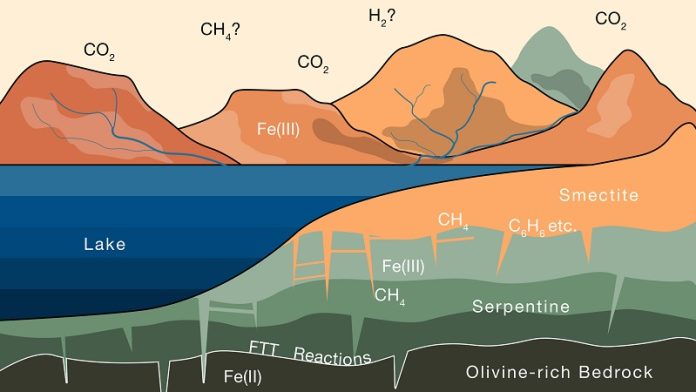
Mars wasn’t always the cold, dry desert we see today. Billions of years ago, water flowed across its surface, indicating that the planet must have had a thick atmosphere to keep that water from freezing.
However, about 3.5 billion years ago, the water vanished, and the atmosphere—once dense with carbon dioxide—thinned dramatically, leaving only a thin layer of air that clings to the planet today.
For a long time, scientists have wondered where Mars’ atmosphere went. Now, two geologists from MIT may have found the answer: it could be locked up in the planet’s clay-rich surface.
In a new study published in Science Advances, recent MIT graduate Joshua Murray, Ph.D. ’24, and Professor Oliver Jagoutz propose that Mars’ missing atmosphere could be hidden in its clay-covered crust.
They believe that during a time when water was still present on Mars, a slow chemical process might have drawn carbon dioxide out of the atmosphere and stored it as methane in the planet’s clay minerals.
Similar processes are known to occur on Earth, where certain types of rocks react with carbon dioxide and water to form stable compounds that can hold carbon for millions of years.
The researchers applied their knowledge of Earth’s geology to Mars, focusing on a type of clay mineral called smectite, which is very effective at trapping carbon.
Smectite clays on Earth are formed through the interaction of water with certain types of rocks, particularly those rich in the mineral olivine.
These rocks react with water and carbon dioxide to eventually produce smectite, which can then trap carbon in its structure. The researchers wondered if a similar process could have occurred on Mars, where smectite is found across much of the planet’s surface.
Mars doesn’t have the same tectonic activity as Earth, so the process of forming these clays would have been different.
However, the team used a chemical model to estimate how Martian rocks, particularly those rich in olivine, might have reacted with water and carbon dioxide over time.
They found that, given enough time—perhaps a billion years—the interaction of water with olivine-rich rocks could have formed large quantities of smectite clay, capable of trapping significant amounts of carbon dioxide as methane.
According to their calculations, if Mars is covered by a layer of smectite clay about 1,100 meters thick, this could be enough to store a huge amount of methane—equivalent to most of the carbon dioxide that was once in the planet’s atmosphere.
This suggests that much of Mars’ early, thick atmosphere could be hidden in plain sight, locked up within the planet’s clay-rich crust.
The implications of this discovery are significant.
Not only does it help solve the mystery of where Mars’ atmosphere went, but it also raises the possibility that some of this sequestered carbon could be recovered and used as a resource for future Mars missions.
For example, the methane stored in the clays could potentially be converted into fuel for rockets or other energy needs.
“This process of carbon storage happens on Earth, and the same types of rocks and clays exist on Mars,” says Jagoutz. “Our study shows that these smectite clays on Mars have a tremendous capacity to store carbon, which could account for a large part of the planet’s missing atmosphere.”
Understanding how these processes work on Mars could also provide valuable insights into the planet’s history and its potential for supporting life. If Mars once had a thick atmosphere and liquid water, it might have been a more hospitable place than it is today.
In conclusion, Mars’ missing atmosphere might not be gone after all—it could be stored in the planet’s clay-rich surface, waiting to be discovered. This finding not only helps explain Mars’ mysterious past but also opens up new possibilities for future exploration and resource use on the Red Planet.
Source: MIT.



